How to Choose the Right Air Duct Filter for Your Home
Your air duct filter is an important part of your HVAC system. It’s the barrier that traps airborne particles, stopping them from circulating into your home and improving indoor air quality. While the air quality in the San Francisco Bay Area is generally good, with a clean air filter, your system will filter out dust, allergens, mold spores, and more, keeping you and your family healthier.
Air duct filter replacement is a simple solution to maintaining good indoor air quality in your home and keeping your heat and air conditioning system running with better efficiency. TRIO Heating, Air & Plumbing provides filter replacement, along with a wide range of heating and cooling system maintenance services to keep your system running smoothly year-round.
Read on to learn more about what air filters are, what they do, and how to find the right filter for your system.

Why Your Air Duct Filter Matters
Your air duct filter stands between you and harmful particulates, filtering dust, dander, pollutants, hair, and allergens from the air you breathe. This helps prevent health issues like allergy symptoms, dry or itchy eyes, headaches, throat irritation, and respiratory problems. The US Environmental Protection Agency (EPA) notes that if you have small children, pets, smokers, elderly folk, or people with allergies or breathing issues in your house, a clean filter is extremely important.
A good HVAC filter will keep your air clear and keep your system running efficiently. The more buildup inside the duct filter, the harder the system has to work. That’s why regular tune-ups are important — they’ll keep your heating and cooling working well and extend the life of the entire system.
Types of Air Duct Filters and Their Benefits
With so many filter types to choose from, how do you know which are the best air filters for your home? The answer depends on the type of HVAC system you have. These are the most commonly used residential air duct filters.
Fiberglass Flat Filters
Commonly found in forced air furnaces, these filters are used to capture large particles before they get into the crucial components of your HVAC system, but they aren’t effective at filtering out microscopic particulates.
Extended Media Filters
These 8-inch-thick stacked filters have pleated cotton or polyester folds to catch smaller air contaminants. They have to be professionally installed as they go inside a specialized filter holder in your ductwork.
Electrostatic Filters
Electrostatic filters create static electricity to make trapping particles easier. The electricity generated acts like a magnet and catches very small particles, including smoke and allergens. These filters don’t need replacement, but they do need to be cleaned every few months using soap and water.
Electronic Filters
These high-tech mechanical filters are plugged into an outlet so they can produce a high-voltage charge generated by a transformer. They’re highly effective at filtering out small particles. It’s important to check the safety rating on your electronic filter before purchasing to make sure they don’t generate ozone, a safety hazard.
High-Efficiency Particulate Air (HEPA) Filters
HEPA filters are pleated mechanical high-efficiency air filters that remove 99.97% of contaminants from the air, including pollen, mold spores, smoke particles, bacteria, and other tiny particles with a size of 0.3 microns.
Ultraviolet (UV) Filters
These are short-wave ultraviolet lights built into the HVAC system to kill microorganisms like bacteria and viruses. These types of filters should be used in conjunction with another type, as they don’t stop dust, hair, or any other particulates.
Gas-phase Filters
This type of filter is uncommon but sometimes used in homes as an add-on to an existing filtration system. They use gas sorption to attract gas molecules to a solid surface, removing odors and volatile organic compounds (VOCs) like ethanol, benzene, or methylene chloride. These filters have a short lifespan and must be replaced frequently.
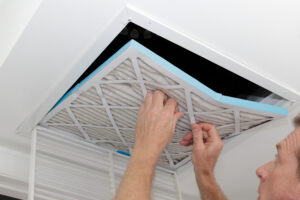
Understanding MERV Ratings and What They Mean
Minimum Efficiency Reporting Values, or MERVs, are the metrics used to measure an air filter’s capability for capturing particles between 0.3 and 10 microns. By looking at MERV ratings for air filters, you can easily compare different filters and their abilities. If the filter has a higher MERV rating, it’ll be better at trapping particles than one with a lower rating.
Filters rated MERV 1-4 have a simple, basic design and will capture large dust and pollen particles. Those with a rating between 5 and 10 can catch mold spores and dust mites, while 11-12 means the filter will stop pet dander and smoke particles, making them better for homes with pets or those living with allergies or respiratory issues. Even higher MERV ratings will capture bacteria and the smallest particles nd are used in hospitals, clean rooms, and laboratories.
How To Choose the Right Filter for Your Home
Choosing the right HVAC filter is important to keeping your indoor air clean and fresh and your heating and cooling system running efficiently. You’ll have to consider your unique household needs and the types of filters that are compatible with your HVAC setup. If you’re not sure, call TRIO Heating, Air & Plumbing We’ll send an expert technician to look at your system and replace the filters for you.
How Often Should You Replace Your Air Duct Filter?
Each type of filter will have manufacturer recommendations for HVAC filter replacement timing, but generally speaking, you should clean or replace the filter when it looks visibly dirty, when you notice allergy symptoms or excess dust in your home, or after 90 days, whichever comes first. The Bay Area isn’t necessarily a dusty place, but the outdoor air quality varies, especially during wildfire season, so you may need to check your filters more often than the manufacturer's suggestion.
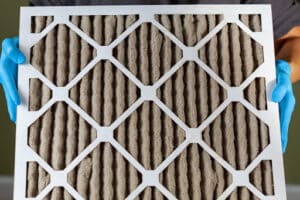
Call TRIO Heating, Air & Plumbing Today
Contact TRIO Heating, Air & Plumbing for all your HVAC questions, concerns, and service needs. We offer everything from a simple filter change to a full system overhaul. We serve the Greater San Francisco Bay Area, including San Jose, Santa Clara, Walnut Creek, Los Altos Hills, San Ramon, and Sunnyvale, CA. Book online or call us today.
How Heating Maintenance Can Improve Your System’s Lifespan
Your heater works hard to keep your home warm throughout the chilly Bay Area winters. However, wear and tear can cause its lifespan to fall short without regular upkeep. Routine tune-ups help catch minor issues before they become more significant problems, boost efficiency, and keep everything working correctly so you can enjoy cozy comfort for years to come. Read on to discover how regular heating system maintenance improves your unit’s lifespan and keeps your home warm and worry-free all winter long.
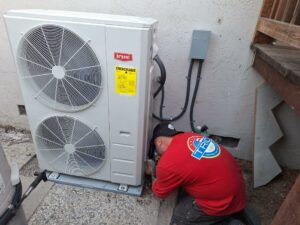
Why Heating Maintenance Matters
Like any home system, your heater needs regular upkeep to keep everything running smoothly. When you schedule professional heating maintenance, a certified technician inspects, cleans, and tunes up your unit from top to bottom. They check that all parts are working correctly, look for potential hazards, and identify minor issues before they progress. These tasks improve your unit’s efficiency, prevent heating repairs, increase its lifespan, and keep your home safe and warm through the chilly winter months.
Key Benefits of Regular Heating Maintenance
Keeping up with regular heating maintenance offers several benefits that improve home comfort, lower bills, and keep your household safe. By taking care of your system, you’ll avoid unexpected breakdowns, improve energy efficiency, and extend its lifespan. Some of the top perks you’ll see include:
- Lower energy bills: A well-maintained heater uses less energy to warm your home, reducing your utility bills and carbon footprint.
- Fewer repairs: During your heating tune-up, the technician will look for and fix any minor issues before they become bigger, more costly problems.
- A safer household: Regular maintenance helps minimize the risk of dangerous carbon monoxide leaks or electrical issues.
- A longer system lifespan: Routine maintenance prevents excessive wear and tear, helping your heater run for years to come.
- Consistent home comfort: With your heater running smoothly, you won’t have to worry about uneven temperatures, poor airflow, or breakdowns keeping you in the cold.
Signs Your Heating System Needs Maintenance
It’s important to schedule a heating system checkup at least once a year to keep your unit running in top condition. If it’s been over a year since your last heating service or you can’t seem to remember when your last service was, it’s a good idea to schedule maintenance. Some other key signs that your heater is overdue for a tune-up include:
- Rising energy bills: A poorly maintained heater uses more energy to warm your home, causing your heating bills to increase.
- A yellow pilot light: Your furnace pilot light should always be bright blue. If it looks yellow, there may be a carbon monoxide leak that requires immediate service.
- Excess dust near the vents: Unchanged or dirty filters cause dust to build up around the vents, decreasing indoor air quality and blocking airflow.
- Strange noises: Grinding, rattling, or banging noises can indicate internal issues that need attention.
- Inefficient heating: If your house takes forever to warm up, your heater may struggle to function due to wear and tear.
- Strange odors: Burning or other foul odors from your heater often indicate dust buildup or mechanical issues requiring service.
How Maintenance Helps Extend Your System’s Lifespan
While most heating systems last 10 to 15 years, regular maintenance can help your unit reach and even exceed this lifespan. Regular upkeep, such as lubricating moving parts, tightening connections, and performing other key tasks, keeps your heater in top condition while reducing wear and tear. By limiting the strain on your system, you’ll boost its lifespan and prevent the need for costly repairs or early replacement.
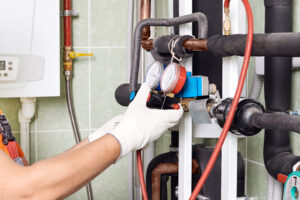
DIY vs. Professional Heating Maintenance
When it comes time for your annual heating tune-up, you may be tempted to do the job yourself. While you can perform a few DIY tasks to keep things running smoothly until your next service, heating maintenance should always be left to the professionals.
Certified HVAC technicians have the skills and experience to perform a comprehensive maintenance checklist, ensuring that all components receive a thorough inspection, cleaning, and tune-up. They can also spot worn-out or failing components that an untrained eye might overlook, helping to prevent more significant, costly issues.
With a professional service, you can rest easy knowing that your heater is in optimal condition, free from safety hazards, and running efficiently for years.
How Often Should You Schedule Heating Maintenance?
It’s important to schedule maintenance at least once a year to prevent breakdowns and keep your heater running efficiently. The best time to book your tune-up is in late summer or early fall before peak heating season begins. This timing helps prepare your heater for the cold winter temperatures ahead.
With a full inspection of your unit during this time, you won’t have to worry about unexpected breakdowns or major issues impacting your home comfort. The technician will catch and repair any minor problems, preventing them from progressing into major repairs. With annual maintenance, you’ll improve your unit’s efficiency and extend your HVAC’s lifespan, keeping your home warm and cozy for many winters ahead.
Call TRIO to Schedule Professional Heating Maintenance Today!
Keep your home warm and cozy for years with professional heating maintenance from the team at TRIO. Our experts offer five-star furnace tune-ups throughout the Greater San Francisco Bay Area that extend your HVAC’s lifespan, improve energy efficiency, and prevent costly repairs. Don’t wait for a breakdown to schedule service. Call our team to book your annual tune-up today!
Want to take your heating maintenance to the next level? Join our maintenance Membership Program to receive bi-annual 29-point HVAC tune-ups, priority service, and other VIP benefits.
Seal the Deal: How Duct Sealing Can Improve Your Home’s Efficiency
The ductwork in your home’s HVAC system is a circulatory system, delivering warm or cool air to every room. When leaks develop in your air ducts, your comfort and wallet can take a serious hit. Many HVAC systems in the United States fail to meet their rated efficiency due to poor installation and leaky ducts. At TRIO Heating, Air & Plumbing , we’ve seen firsthand how professional duct sealing services can vastly improve the efficiency of HVAC systems.
Why Duct Sealing Is Important
Think of your air duct system as a network of pathways. These ducts travel behind walls, through attics, and crawl spaces. When they develop leaks, they lose the heated or cooled air destined for another room in your home.
They’re also pulling in whatever happens to be in those hard-to-reach places. This could include insulation fibers, dust, moisture, mold, and even asbestos particles in older homes. Beyond the obvious waste of energy, air duct leaks can significantly harm indoor air quality and put your family’s health at risk. Above all else, this underscores why duct sealing is important.
The unique San Francisco Bay Area climate presents specific challenges for our HVAC systems. The frequent fog and the marine layer bring in moisture that can accelerate duct deterioration, while our mild winters and warm summers mean your HVAC system likely needs to work all year round. Many Bay Area homes, especially in older neighborhoods, have ducts running through unconditioned spaces like attics, making them more susceptible to leaks and efficiency losses.
Key Duct Sealing Benefits
When you invest in proper duct sealing, you invest in many notable benefits for your home and family.
Enhanced efficiency
When air ducts are properly sealed, conditioned air reaches its intended destination instead of leaking into unused spaces. Duct sealing improves energy efficiency by sealing leaky ducts, which can improve HVAC system performance and efficiency by up to 20%. This direct air delivery means your system maintains comfortable temperatures without working overtime.
Lower utility bills
You can significantly reduce energy bills with duct sealing. Most homeowners see a noticeable difference in their monthly utility bills right away. Given that the Bay Area’s energy costs are among the highest in the country, this benefit is especially significant for local homeowners.
Improved air quality
Sealed ducts prevent contaminants like fog-carried moisture, outdoor allergens, and attic dust from entering your living space. Good indoor air quality is vital for the health of your family members. Properly sealed ducts are especially important during wildfire season to prevent outdoor smoke from infiltrating leaky air ducts.
Consistent home comfort
Along with other duct sealing benefits, this professional service can eliminate frustrating temperature variations between the different rooms in your home. This is especially noticeable in multi-story homes in the Bay Area. Duct sealing can help maintain even temperatures across different floors, keeping your home consistently comfortable from room to room.
Extended equipment life
Another reason why duct sealing is important is when your HVAC system doesn’t have to fight against air duct leaks, it experiences less strain and operates more efficiently. This reduced workload helps prolong the service life of your HVAC system, postponing the need for costly repairs and replacements and reducing maintenance requirements.
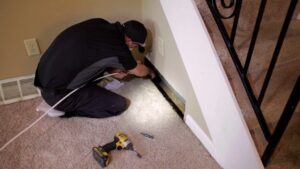
Signs Your Ducts May Need Sealing
Look out for these telltale signs that your air ducts need professional attention:
- Excessive condensation around vents during foggy days
- Musty odors when running the system, especially in the morning
- Higher humidity levels indoors than expected
- Unusually high energy bills, especially during peak heating or cooling periods
- Rooms that are constantly too hot or too cold
- Stuffy or uncomfortable air quality
- Visible dust around your air vents
- The HVAC system is running constantly but failing to maintain temperature
- Black marks on the insulation around your ductwork
- Respiratory issues or irritation among household members when the system is running
Questions to Ask Your HVAC Professional
When considering professional duct sealing services, working with qualified technicians is important. Here are a few key questions to discuss:
- What methods and materials will be used for duct sealing?
- How will you identify possible leak points?
- Will you be testing to verify the effectiveness of the air duct sealing?
- How long will the new seals last before they need to be repaired or replaced?
- Do you have any maintenance recommendations to prolong the life of the sealing?
- Can you provide before and after efficiency measurements?
- Are there any specific challenges Bay Area homeowners should be aware of?Do you offer a guarantee or warranty on your work?
- Do you offer financing options and maintenance plans?
DIY vs. Professional Duct Sealing
Some homeowners may consider a DIY approach, but professional duct sealing services offer several advantages. A common misconception is that regular duct tape is sufficient for sealing, but it deteriorates quickly. Some people may believe that small leaks don’t matter, but they can reduce efficiency by as much as 30%. Even new home construction can have duct leakage.
At TRIO Heating, Air & Plumbing , our professional approach starts with a comprehensive inspection. Our technicians evaluate your HVAC system using specialized equipment to detect leaks and assess airflow. Next, we clean the air ducts to improve HVAC system performance and remove any debris that could compromise airflow or undermine the duct sealing process.
The professional duct sealing process may include high-quality HVAC sealant tape, high-temperature-resistant silicone sealant, and mechanical fasteners for long-term stability. After sealing, we’ll conduct pressure testing to verify the work's effectiveness and ensure all leaks have been addressed.
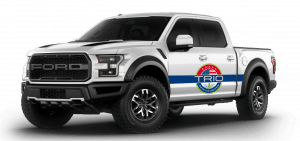
Book Professional Duct Sealing Services Today
Don’t let leaky ducts blow your energy bills out of hand. Contact TRIO Heating, Air & Plumbing to schedule your professional duct sealing service and start saving on energy bills. Our experienced technicians will thoroughly inspect your air ducts, identify all leak points, and seal them properly for top performance and air quality. Duct sealing is about more than energy savings — it’s about creating a healthier, more comfortable home year-round.
When to Call a Professional for Heating Repair: A Homeowner's Guide
A functioning heating system is your secret weapon to keeping the Greater San Francisco Bay Area winters cozy while at home. But just like any hard-working appliance, your HVAC isn’t immune to wear and tear. Ignoring the warning signs only leads to bigger problems, potentially costly repairs, and even safety hazards.
While minor issues could be handled on your own, you may not know what to look out for, and DIY fixes could lead to major problems down the road. We’ll help you identify the key red flags that signal it's time to bring in TRIO’s heating experts, ensuring your home stays warm and safe all season long.
The Importance of Annual Heating Maintenance
Annual heating maintenance of your system helps keep the heat flowing throughout the cooler months. Regular service can identify and resolve unexpected issues, improve energy efficiency, and even extend the lifespan of your heating system.
A trained professional can spot even minor issues before they become major repairs, helping your furnace, boiler, or heat pump operate to its full standard and reducing future repair and replacement costs.

What are the Consequences of Skipping Heating Maintenance?
Skipping your system’s annual heating maintenance can lead to more headaches shortly. Higher energy bills, unexpected breakdowns, and a shorter system lifespan are just a few of the issues you could face.
The importance of heating maintenance is easy to see. In terms of safety and health, neglected filters can worsen your indoor air quality, and undetected gas leaks or carbon monoxide buildup could pose more serious safety risks.
Don’t wait until the temperature drops and you’re left in the cold. Regular maintenance helps your system run more efficiently for longer, keeping you warm and safe all season.
Key Steps for Preparing Your Heating System for Winter
A well-prepared heating system will keep your home warm, energy efficient, and safe as temperatures drop. Scheduling a professional tune-up is the #1 step to help get your heating system winter-ready and to avoid costly surprises when you need heat the most.
Replacing Dirty or Clogged Air Filters
A clogged air filter reduces airflow and makes your system work harder and less efficiently. Replacing an air filter every 1–3 months helps keep the heat running at peak performance.
Solving Thermostat Issues
Incorrect settings, low batteries, and a miscalibrated thermostat can all lead to heating problems. Adjusting the settings and changing the batteries often resolves minor issues
Clearing Vent Pathways
If you’re noticing some areas in your home are colder than others, a professional can check for obstructions and ensure proper airflow from the vents.
Tending to Pilot Light or Ignition Problems
If your pilot light doesn’t stay lit, it could be due to several issues, including a faulty sensor, a clogged pilot orifice, or even a draft blowing it out. A weak or flickering flame — especially one that appears yellow instead of blue — may indicate a gas mixture problem, which requires immediate professional attention.
Investigating Unusual Noises
If you’re hearing rattling or whistling sounds, a professional can tighten loose panels or clean out debris from ducts.
Cleaning Dusty Components
Accumulated dust on burners, sensors, or heat exchangers can reduce efficiency, but these components are typically cleaned and inspected during annual heating maintenance to keep your system running smoothly.
By getting ahead of heating system preparation, you’ll enjoy a warm, safe, and stress-free winter.
Benefits of Professional Heating Maintenance Services
Yearly professional maintenance is a smart investment that keeps your heating system running efficiently, safely, and reliably throughout the colder months. From improved air quality to enhanced safety, the heating maintenance benefits go beyond just simple fixes to keep the warm air flowing.
Benefits include:
- Increased Energy Efficiency: A technician can clean, inspect, and optimize your heating system to reduce energy consumption and lower your heating costs.
- Fewer Repairs and Breakdowns: Catching minor issues early helps prevent costly repairs and unexpected system failures.
- Extended Equipment Lifespan: Regular maintenance reduces system wear and tear, helping your system last longer and delaying replacement costs.
- Improved Indoor Air Quality: Cleaning components and replacing filters prevent dust, allergens, and pollutants from circulating in your home and the air you breathe.
- Enhanced Safety: Professionals know to check for gas leaks, carbon monoxide risks, and electrical issues to further protect your household.
- Consistent Home Comfort: A well-maintained system distributes heat evenly, eliminating cold spots and temperature fluctuations.
- Peace of Mind: Knowing your system is in top condition lets you enjoy winter without worrying about unexpected heating issues.
Professional maintenance is a smart investment that keeps your heating system running efficiently, safely, and reliably throughout the colder months.
How Annual Maintenance Saves You Money in the Long Run
While it may seem like an added expense, investing in annual heating maintenance saves you money over time. By preventing more costly repairs in the future, the added heating maintenance benefits include improving efficiency and extending your system’s lifespan, saving you money in the long run.
A well-maintained heating system runs more efficiently which in turn reduces your energy consumption and lowers your monthly utility bills, which is especially noticeable in the colder winter months.
Though they might seem like harmless issues, regular inspections can catch minor issues like worn-out parts or dirty, clogged filters, which could turn into expensive breakdowns or emergency repairs.
By keeping your heating system in peak form, annual heating maintenance ensures long-term savings and reliable comfort throughout the winter months.
When It’s Time to Upgrade Your Heating System
Heating systems are the heart of a comfortable and cozy home, but what happens when yours starts to act up? Recognizing the warning signs early can help you decide when it’s time for a new system. Here are three signs to watch for:
- Frequent repairs: If your furnace or heat pump is breaking down frequently, it may be more cost-effective to replace it rather than to keep paying for repairs. Constant service calls can add up fast, and upgrading to a new, energy-efficient system could save you money in the long run while keeping your home reliably warm.
- Age matters: Age plays a big role in deciding when to replace your heating system. Most furnaces last between 15 to 20 years, but if yours is approaching or has surpassed that mark, it may be time to start thinking about an upgrade.
- Inconsistent temperatures: You might notice certain rooms are feeling colder than others. If your furnace is struggling to keep your home consistently warm, uneven heating is often a sign that your system is losing efficiency and may need an upgrade.

Investing in Your Home’s Future with TRIO Heating, Air & Plumbing
Specializing in electric, oil, and gas furnace heating maintenance services, the team at TRIO understands the importance of keeping your furnace in tip-top condition. Using leading equipment and knowledge for the best results, we can optimize your heating system for efficiency and comfort by examining 27 critical components, from cleaning and lubricating moving parts to calibrating your thermostat.
Schedule your annual heating maintenance with TRIO Heating, Air & Plumbing today to keep safe and warm throughout the cold winter months.
The Importance of Annual Heating Maintenance: Preparing for the Chill Ahead
Heating maintenance is preventative care that includes a full heating system inspection, cleaning, and even small repairs. It’s good for every home, and homeowners should schedule their heating maintenance appointment in the fall before the cold weather hits.
TRIO Heating, Air, & Plumbing is available to service your home heating system so you can rest easy knowing your heater will keep your family warm all winter long. We’re San Francisco locals, so we understand how the winter chill can set into your home. You need a furnace that works well — we’re here to help ensure your heating system always runs at peak performance.
The Importance of Annual Heating Maintenance
Annual heating maintenance is the best way to keep your furnace running at peak performance. It allows your professional HVAC technician the chance to look over the entire system and find and fix any small issues before they become a big deal. This can save your furnace from catastrophic failure mid-winter and help prevent thousands of dollars in repairs or replacement costs.
Annual heating maintenance is crucial for the longevity of your heating system. In some cases, scheduling annual heating maintenance calls can make all the difference between your furnace lasting only eight years or more than twenty.
Cleaning out grime and fixing small issues reduces wear and tear and keeps your heating system running efficiently. A clean furnace uses less power or fuel to do its job, saving you on your energy bills and reducing your home’s environmental impact, even if your furnace is on 24/7.
Consequences of Skipping Heating Maintenance
What happens if you ignore your furnace and don’t maintain your heating system? If you skip heating maintenance, blast the heat all winter long, and hope for the best, you’ll likely notice your furnace starting to have difficulty maintaining a consistent temperature in your home. It might be cold in one room and hot in another, or the furnace will turn on and off quickly without thoroughly heating the space.
You may also notice bad smells from your vents and more dust around the house. Your indoor air quality might worsen, with more allergens, pollen, and mold spores getting dispersed through the vents.
Over time, smaller problems like a loose belt or faulty valve can become big issues requiring extensive (and costly) repairs. Your furnace may even fail, leaving you in the cold. Depending on the weather, this can also lead to burst pipes in your home.
If you have a gas furnace, neglecting maintenance is dangerous. A small issue can grow until it causes a gas leak, and your furnace may become a fire hazard over time if certain internal systems fail.
If you never have your furnace professionally maintained, you may be in danger of voiding your HVAC system’s warranty. Most mandate that the service life of the furnace depends on regular tune-ups.
Key Steps for Preparing Your Heating System for Winter
If you keep a winter checklist for home maintenance, make sure to include the following heating system preparation steps:
- Do a filter check, and replace or wash the filter if it’s been in place for over 90 days or looks dirty.
- Test your thermostat by turning on the heat, then slowly raising the temperature in five-degree increments. If the furnace doesn’t quickly kick on and start heating the home, you may need an expert to find the issue.
- Look for water leaks around the furnace. This is a common problem with high-efficiency models, and the water can damage the furnace or even cause mold to grow in your house if it’s not addressed. Call an HVAC professional to fix the leak.
- Listen closely to the furnace when it’s on, and call an expert if it starts making squeaking, clicking, squealing, banging, or booming sounds. These can indicate small problems or dangerous issues, so addressing them quickly is a good idea.
If you have a gas furnace, you should also have the pilot light, flame sensor, and gas lines checked out by an expert to ensure your system is safe.
Benefits of Professional Heating Maintenance Services
The benefits of hiring TRIO for heating maintenance include:
- Improved home comfort and safety, with efficient heat all winter long
- Less stress, knowing your heating system is working at its best
- Lower heat bills and fewer costly repairs
- Better air quality, with fewer allergens, mold spores, and other nasty particulates in the air you and your family breathe
- Staying within the terms of your furnace’s warranty
- Trustworthy service — you can count on us to show up on time with good quality parts
How Annual Maintenance Saves You Money in the Long Run
One of the biggest heating maintenance benefits is the money you’ll save. Keeping your furnace running at its best means you’ll have more efficient heating throughout your home, better air quality, and lower energy bills.
HVAC maintenance is necessary to prolong the service life of your furnace and keep you on good terms with the unit’s warranty.
When It’s Time to Upgrade Your Heating System
Unsure if it’s time to upgrade your heating system to a newer model? Here are some of the biggest signs it’s time to replace your current system:
- Uneven heat throughout your home or no heat coming from the vents at all
- Higher-than-usual energy bills as the furnace starts running less efficiently
- Your furnace is over 10 years old
- Loud noises when the furnace is running, including rattling, popping, screeching, or humming.
- Issues starting up, like when a gas furnace doesn’t ignite the gas properly
- Parts are harder to find because the furnace model is outdated
- Repair bills are getting out of hand
Installing a new furnace may be less expensive than repairs in the long term. It’s better to upgrade your furnace before it possibly breaks down in the dead of winter. In that case, you may be without heat until a technician can do the replacement, leaving you vulnerable to burst pipes and discomfort in a cold house.
A new furnace also comes with plenty of benefits, like programmable thermostat options, smart-home integration, and fast, efficient heating you’ll love.
Contact TRIO for Your Annual Heating Maintenance
TRIO is here to provide annual heating maintenance and any other services you need for your HVAC system. Contact us today to schedule an appointment and we’ll show you why we’re known for providing the top heating and air services in the Greater San Francisco Bay Area. Book your annual heating maintenance appointment now so you can be confident that your home heat system is in peak condition when the temperature drops.
Winter Heating Maintenance Checklist: Keep Your System Running Smoothly
As the winter chill sets in across the San Francisco Bay Area, your home’s heating system must be ready to keep your family warm and comfortable. At TRIO Heating, Air & Plumbing, we understand that proper heating maintenance is crucial for ensuring your safety and peace of mind, especially during the coldest months of the year. Follow this comprehensive guide to walk through everything you need to know about winter heating maintenance, helping you keep your HVAC system running smoothly and efficiently all winter.
Importance of Winter Heating Maintenance
Regular heating maintenance is more than just a recommended practice — it’s essential for the longevity and performance of your home’s HVAC system. Preventative maintenance helps to identify and remedy issues that may otherwise lead to unexpected breakdowns. It also improves energy efficiency and can save you significant money in the long run.
A well-maintained heating system:
- Reduces the risk of costly emergency repairs
- Improves overall energy efficiency
- Extends the service life of your heating equipment
- Ensures consistent and reliable performance
- Maintains optimal indoor air quality
Signs Your Heating System Needs Immediate Attention
Before winter reaches its peak, watch out for these critical red flags that may indicate your home’s heating system requires professional attention:
- Unusual noises, like banging, rattling, or squealing sounds
- Inconsistent heating, resulting in cold spots or uneven heating across different rooms
- Spikes in heating costs, pointing toward possible system inefficiency
- A heating system that frequently turns on and off for no apparent reason
- Unpleasant odors may indicate mold, mildew, gas leaks, or faulty electrical components
Winter Heating Maintenance Checklist: Step-by-Step Guide for DIY Tasks
While professional inspections and service are crucial, homeowners can follow these heating system maintenance tips to keep their HVAC working at its best.
Air filter maintenance
Regularly replacing or cleaning air filters is one of the easiest and most important DIY heating maintenance tasks. Dirty filters restrict airflow, reduce system efficiency, and can cause unnecessary strain on your heating system.
For most homes, replace disposable filters every few months or clean reusable filters once every month or two. Mark your calendar or set a reminder to ensure you don’t forget this step, particularly as part of your winter heating preparation routine.
Outdoor unit care
If you have any HVAC components that are outside of your home, be sure to keep the area around it clear of debris, leaves, branches, and snow. Maintain at least a two-foot clearance around the unit to ensure proper airflow and prevent potential damage. During winter, remove any snow or ice buildup carefully, avoiding direct contact with delicate components.
Seal and insulate
Conduct a thorough check of all windows, doors, and other potential sources of air leaks. Use weatherstripping, caulk, or draft stoppers to seal any gaps that could let warm air escape. Pay special attention to areas around window frames and door thresholds. Proper sealing reduces your heating system’s workload and thus lowers your energy bills too.
Vent, register, and grille maintenance
As a homeowner, a regular part of your winter heating preparation checklist should include checking all air vents and registers to ensure they are completely unobstructed by furniture, rugs, or curtains. Vacuum these areas regularly to remove dust and debris that can impede airflow. Use a soft brush attachment to clean vent covers and remove dust.
Professional Heating Maintenance Checklist
Our expert heating technicians offer a comprehensive heating maintenance service. To keep your HVAC system operating at an optimal level, we recommend scheduling a heating maintenance call at least once a year. This can identify some of the most common heating system problems in winter, like malfunctioning thermostats, pilot light issues, dirty air filters, clogged air filters, duct leaks, and burning smells.
Thorough system inspection
Our technicians meticulously examine every critical component of your heating system. We carefully check for signs of wear and tear, inspect electrical components for potential hazards, and assess overall system performance. This detailed evaluation identifies potential issues before they become major problems.
Cleaning and optimization
Our cleaning service goes far beyond a simple surface wipe-down. To help maintain your heating system’s peak efficiency, we clean burners and heat exchangers, removing built-up dust, debris, and potential corrosion. We lubricate all moving parts to reduce friction and wear, which can significantly extend your system’s lifespan. Air filters are cleaned or replaced, as needed, as the thermostat is precisely calibrated.
Safety checks
Safety is our top priority. We check carbon monoxide levels, verify gas pressure and connections, and inspect the heat exchanger to look for any cracks or damage that could compromise system safety. We also verify proper ventilation to prevent any potential safety risks.
Performance testing
As part of the regular heating maintenance checklist, our technicians measure the efficiency of your system, including airflow and temperature differentials, heating cycle operation, and energy consumption. We check for any irregularities in startup, running, and shutdown processes, ensuring your heating system operates reliably throughout the winter months in the San Francisco Bay Area.
Benefits of Scheduling Professional Heating Maintenance
Investing in professional heating maintenance is crucially important for several reasons:
- Enhanced efficiency: A well-maintained heating system can improve energy efficiency, directly lowering your monthly utility bills.
- Preventative care: Detailed inspections can reveal potential issues before they become major problems requiring costly repairs or replacement.
- Extended system life: Regular maintenance can add years to your heating system’s usable lifespan.
- Improved comfort: Ensure consistent, reliable heating throughout your home all year round.
When to Replace Your Heating System
It’s never easy to decide that you need to replace your home’s heating system. It’s a decision that requires careful consideration. In most cases, age is one of the biggest factors. Most heating systems have an optimal lifespan of 15 to 20 years. However, age alone isn’t the only indicator. You must pay close attention to your system’s performance, efficiency, and repair frequency.
If you find yourself facing increasingly frequent and expensive repairs, it may be a more cost-effective choice to invest in a new, energy-efficient system. Rising energy bills, despite regular maintenance, can also signal it’s time to consider a replacement. Modern heating systems offer significant improvements in technology, energy efficiency, and overall home comfort.
Schedule Your Winter Heating Maintenance Today!
Don't let the winter catch you unprepared. Protect your home, ensure your comfort, and save money with TRIO Heating, Air & Plumbing 's professional heating maintenance services.
Call TRIO Heating, Air & Plumbing today at (415) 226-4125 or contact us online to schedule your professional heating maintenance service! We promise prompt customer service and are dedicated to delivering superior work with every job.
